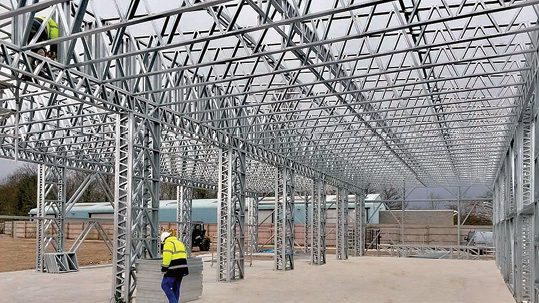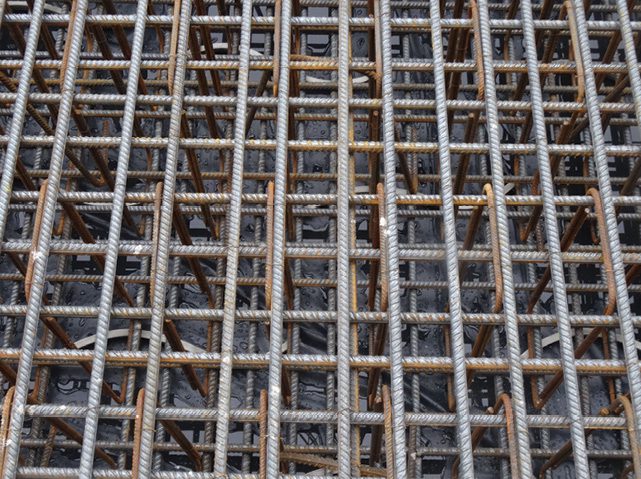AI Brings a New Era of Sustainability to Structural Engineering

Construction workers put together a truss frame designed through AI.
Every year brings new technological innovation to the engineering sector. For example, the industry now is in an age in which 3D-printed structural parts and generative-design artificial intelligence (AI) work together to suggest bridge concepts.
The pressure to balance resource-intensive machinery and tech tools with sustainability is more critical, especially as more people and businesses are aware of the dangers of climate change. Corporations are responsible for disclosing and publicizing green goals and metrics, so experts are finding ways to use AI for eco-friendly endeavors.
The Ultimate Collaboration
The endless creativity of humans combined with the intellectual data-driven power of AI is an equation for optimized structural engineering ideation. Including big data and the latest knowledge in sustainability empowers the sector even more. New research explores how the relationship helps all engineering fields, from transportation to biomedical.
Adopting AI for sustainable structural engineering forces the following:
• Better sustainability reporting
• Awareness of green metrics such as emissions and waste
• Process discovery for greener opportunities
• Collaboration with third parties
• Updated training for employees
AI provides insight, and people inject input. It’s necessary to include the human element for fact-checking potential AI hallucinations and leveraging how efficiently AI computes vast quantities of data. If there’s a glaring concern, engineers command AI to reconsider while recording why the sequence failed. Algorithms will need constant oversight and data curation, keeping structural engineers alert to ensure they consider practical specs and environmental aspirations with equal gravity.
Feedback is vital for incorporating emotional or creative value into a suggestion or design lacking inspiration. For example, aesthetics are not essential to mechanical equipment for constructing skyscrapers. Adversely, wearable medical equipment needs visual appeal to please consumers. A B2B customer may only accept designs if they align with their brand aesthetic or encapsulate modernity, so more thought needs to go into each specific project to appeal to clients.
It’s time to phase out automated design generation, which provides less-organic offerings that only consider some specifications. Every interaction and concept becomes a two-way conversation between AI and humans for a swiftly generated, practical structure for thoughtful, sustainable implementation. This tailors each project to individual needs and improves client satisfaction.
The History of AI and Structural Engineering
Innovators have traversed the sector for decades, using previously exclusive AI tools to rethink old patents and go-to structures. Each iteration of an idea improves efficiency and sustainability concerning cost or carbon emissions, appealing to increasingly eco-aware clients.
An alternative to the commonly used space trusses was reinvigorated in 2002 because of neural networks in AI (see bit.ly/3YV2ZNr for more information). Trusses require costly and heavy steel. The designs are complex with varying weight distributions, which is better for statistically indeterminate projects where equilibrium is constantly in flux. AI information produced solutions that reduced the weight and stress traditional trusses caused, proposing and predicting the success of other cheaper, more-sustainable construction material properties.
In 2020, AI modeling answered a material replacement hypothesis: could structural engineers replace steel rebar with glass fiber-reinforced polymer bars? These rest in environmentally questionable concrete columns, so making any adjustments to its footprint is an improvement. Engineers explored the accuracy of AI neural networks in docking up models vs. humans, and the result demonstrated enlightening accuracy (see bit.ly/44CKRsG).
The most-prominent challenge with the overlap of engineering and AI is that information is sparse, and it will be detrimental to niche engineering projects if workers don’t fix the gaps. For example, how can engineers design medical buildings to withstand hurricanes without information on how to do so?
What structural engineers take away from examples contributes to research. AI creates more streamlined design concepts, but the dataset needs input to get smarter—this only happens with research and development. Civil engineers must do this alongside AI—instead of against it—to contribute to the well of knowledge that informs future building developments worldwide. The more information it has (old and new), the more complex problems it solves.

Images show an arrangement of square skylights (top) and a rebar structure for pouring concrete (bottom). Both lattice structures were developed with a form of AI.

The Sustainability Component
AI provides constant analysis of parts vs. industry needs. For example, lithium-ion batteries and aerospace mechanical components are heavy, deterring progress for both sectors. These are high-priority concerns for environmentalists, especially when the byproducts are habitat and resource stressors that damage the natural world.
Maximizing AI decision-making skills identifies prospective options for prototypes without wasting materials to make them. Every determination prevents countless hours of brainstorming and fruitless concept trials, which equates to a more-optimal workflow that reduces materials, fuel, resources and costs.
Experiments describe how an AI assistant will refine topology optimization, which has countless opportunities to increase sustainability by maximizing space and resource efficiency. Engineers provide input to AI to surmise the best outcome while considering critical components such as compliance minimization and sustainable compliance (see bit.ly/3RajF1g). Can new, upcycled material effectively prevent buckling? How likely is the stress to cause a fracture or safety issue?
AI knows about the load-bearing capabilities of every beam and the strength of each connecting thread based on specs and material composition. Structural engineers review determinations and adjust sizes and requirements to fit sustainable standards. The program is malleable, and the AI’s algorithm adapts accordingly to meet specific needs.
AI in the Field
Engineers train AI to become more eco-conscious as it gathers data and generates determinations. It will shine in exceptional situations where structural engineers work with limited materials or structures with outside influences. AIs reduce carbon footprints and increase ecological awareness for engineering enterprises, but how does it work in the field?
For example, the climate crisis is ramping up the intensity of severe weather events. Everything from sandstorms to floods ravage towns and destroy critical and residential infrastructure. Structural engineers must get to the scene to provide quick-to-install solutions to restore essential services to citizens. Time is limited, resources are scarce, and reduced connectivity may not permit extensive research.
Using AI will aid sustainability in a few ways:
First, it provides solutions to mitigate the negative impacts of climate change for citizens. For example, what’s the safest and healthiest way to restore water utilities or reopen a main highway? AI could create that design and predict with 98-percent accuracy how likely it will flood again (see bit.ly/44Apokn). In critical situations, removing manual calculations from the structural engineering landscape is crucial to eliminate human error.
Second, AI delivers planet-friendly ways to execute structural engineering without worsening the environment. It can perform structural analysis in its current state. Engineers feed which materials and tools are available, how the weather impacted the work areas, and which essential eco-friendly concerns they want the design to address. A region hit by a wildfire, for example, is concerned with managing and working around poor air quality. How do structural engineers collaborate with AI to discover how to design solutions to eliminate worry?
The Greening of Construction
AI increases sustainability outside the engineering niche by influencing business partners. Structural engineers must work with the construction industry to make their projects come to life, and their AI-infused design solutions add more green options to decarbonize and improve the planet from their point of view. When 30 percent of construction and demolition materials go to waste, it’s more important than ever.
The construction project will inherently be more environmentally attuned from algorithmic data and human suggestions, translating to third-party vendors and eco-friendly expectations. Predictive maintenance is a priority in these communications. Structural engineers convey the relevance of structural health monitoring tools and considerations during building. In addition, they encourage structures compatible with AI tools to notify facilities of necessary preventive maintenance based on algorithmic predictions and fault detection.
The Internet of Things and sensors are mainstays in environmental technology and greener structures. Maintaining consistent building health checkups and increasing access to constant data streams reveals every eco-friendly metric, from energy usage to volatile organic compound density.
AI enhances the value engineering of any project to function more ideally and sustainably, including cost, use and exchange values. Algorithms such as random forests create numerous potential outcomes for a scenario judged on historical data, streamlining communication among engineers and construction workers.
Ideally, AI becomes so informed about the latest trends and research that it suggests green construction elements as part of the structural engineering concept process. It could include greener alternatives to the following:
• Insulation (cellulose)
• Resource-intensive materials (new concrete that acts as a carbon-sink)
• Energy compatibility (electrical fit for geothermal or EV charging)
• Nontoxic paints and building parts (nature-based solutions)
• Design and orientation (passive solar design)
Finding alternatives through AI in engineering is a top priority for materials such as concrete, which contribute 8 percent of the world’s greenhouse gas emissions. Companies that consider eco-friendly substitutions have an advantage in attracting sustainably minded clients.
The Compliance Question
Regulatory bodies are working out the details of the world’s leading environmental legislative standards. Many organizations find it complex to achieve sustainable outcomes, and AI softens the obstacle for every engineering and construction outfit. Green compliance will become a requirement, no matter what trajectories now suggest. Eventually, AI will assist structural engineers in considering eco-compliance when crafting builds.
The AI companion will be indispensable because it provides improvement opportunities based on auditor feedback from previous years or recent studies that could yield changes in the sector. Predictive analysis could suggest operational or supply chain changes to civil engineering firms before compliance organizations release the next requirements.
A company may need to reduce the amount of timber waste it produces, for example, or adjust budgets to acclimate to new sustainable materials. AI could craft suggestions that save the hours required to prepare for any compliance inspection.
The following common certifications and compliance frameworks can be ideal places to start for structural engineers:
• Green Building Standards
• Living Building
• Energy Star
• International Green Mark
• Greenguard
• ISO 14021 and 14025
• Forest Stewardship Council
• Cradle-to-Cradle
• Green Squared
Because AI procedurally generates information, businesses provide auditors with data to justify the reasons for making eco-conscious decisions. For example, someone may wonder why a building used environmentally exploitative steel vs. an alternative. AI details why the tradeoff matters for overall sustainability and resilience based on carbon projects and prospective environmental degradation, especially for the structure’s lifetime. Will it withstand the region’s climate better, garnering fewer repairs or renovations? Will it save fuel because it repurposed steel scraps? Does it better support sustainable systems?
Employing AI as a vital player in ecological compliance frameworks will keep engineering firms competitive and certified.
In addition, AI forces civil engineers to enter a new world of technological discourse and sustainability considerations. Eventually, it could meld with other booming tools such as augmented and virtual reality for more-comprehensive visualizations and trials. AI is optimizing processes, eco-friendly design and material suggestions, making engineers more flexible in critical jobs, and training algorithms for a climate-aware engineering future.
About Jane Marsh
Jane Marsh is a freelance writer and editor in chief of Environment.co; email: [email protected].


